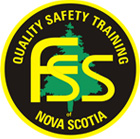Storage and Handling Compressed Gases
Hazards Identified
Fire, explosion, projectile, asphyxiation, frostbite
Hazard-Specific Personal Protective Equipment
Eye protection, gloves
Hazard-Specific Training
Safe Work Practice
- Storage areas should be clearly identified, dept dry and well ventilated.
- Protect cylinders from contact with ground, ice, snow, water, salt, corrosion and high temperatures.
- Store oxygen separately from fuel gases by at least 6 metres (20 feet) or by a 1.5 m (5ft) high with ½ hour resistant rated wall.
- Mark and store empty cylinders away from full cylinders. Return empties to supplier as soon as possible.
- Mark storage areas with “No Smoking” signs.
- Do not use a cylinder that is not identified or if label is not legible. The colours of industrial gas cylinders are not standardized.
- Never use a flame or boiling water to thaw a frozen valve.
- Keep cylinders from becoming part of an electrical circuit.
- Do not use a cylinder as an electrical ground connection.
- Do not fasten cylinders to a work table or to structural members of the building where they could become part of the circuit. Isolate cylinders with suitable electrical insulation.
- Store regulators which have been removed from cylinders away from grease and oil.
- Put protective caps on the fittings when in storage.
- Keep cylinders and fittings from becoming contaminated with oil, grease, or dust.
- Do not try to refill a cylinder or mix gases in a cylinder.
- Move cylinders with appropriate trolleys: use proper lifting cradles.
Storage and Handling Compressed Gases (continued)
- Do not drag, slide, or drop cylinders. Cylinders can be rolled for short distance on their base.
- Do not sling with ropes or chains and do not lift with an electromagnet.
- Do not transport leaky cylinders.
- Transport cylinders in a securely fastened upright position with protective cap in place (for exceptions, see Occupational Safety General Regulations, Section 49)
- Never place cylinders on their side as rollers to move equipment.
See also – Safe Work Practice: Storage of Flammable Materials
Regulations, Standards and References
Occupational Safety General Regulations
